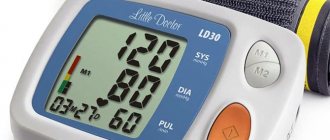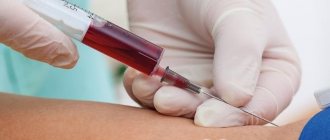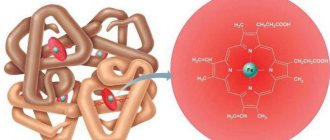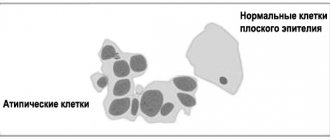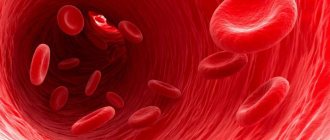An electrocardiogram of the heart is the main diagnostic study that allows us to draw conclusions about the functioning of the organ, the presence or absence of pathologies and their severity. The interpretation of the ECG of the heart is carried out by a cardiologist who sees not only the curves on paper, but can also visually assess the patient’s condition and analyze his complaints.
The indicators, collected all together, help make the correct diagnosis. Without making an accurate diagnosis, it is impossible to prescribe effective treatment, so doctors especially carefully study the patient’s ECG results.
Brief information about the ECG procedure
Electrocardiography studies the electrical currents generated by the human heart. This method is quite simple and accessible - these are the main advantages of the diagnostic procedure, which has been carried out by doctors for quite a long time and doctors have accumulated sufficient practical experience in interpreting the results.
The heart cardiogram was developed and introduced in its modern form at the beginning of the twentieth century by the Dutch scientist Einthoven. The terminology developed by the physiologist is still used to this day. This once again proves that ECG is a relevant and in-demand study, the indicators of which are extremely important for diagnosing heart pathologies.
What pathologies can be identified when decoding data?
Although the ECG is one of the extremely simple studies in structure, there are still no analogues for such a diagnosis of cardiac abnormalities. You can become familiar with the most “popular” diseases recognized by ECG by examining both the description of their characteristic indicators and detailed graphic examples.
This disease is often recorded in adults during ECG, but in children it manifests itself extremely rarely. Among the most common “catalysts” of the disease are the use of drugs and alcohol, chronic stress, hyperthyroidism, etc. PT is distinguished, first of all, by a frequent heartbeat, the indicators of which range from 138–140 to 240–250 beats/min.
Due to the occurrence of such attacks (or paroxysms), both ventricles of the heart do not have the opportunity to fill with blood in time, which weakens the overall blood flow and slows down the delivery of the next portion of oxygen to all parts of the body, including the brain. Tachycardia is characterized by the presence of a modified QRS complex, a weakly expressed T wave and, most importantly, the absence of a distance between T and P. In other words, groups of waves on the electrocardiogram are “glued” to each other.
The disease is one of the “invisible killers” and requires immediate attention to a number of specialists, since if left untreated it can lead to death
Bradycardia
If the previous anomaly implied the absence of the TP segment, then bradycardia represents its antagonist. This disease is indicated by a significant prolongation of TP, indicating weak conduction of the impulse or its incorrect accompaniment through the heart muscle. Patients with bradycardia have an extremely low heart rate index - less than 40–60 beats/min.
If obvious signs of bradycardia are detected, you should undergo a comprehensive examination as soon as possible.
Ischemia
Ischemia is called a harbinger of myocardial infarction; for this reason, early detection of an anomaly contributes to the relief of a fatal ailment and, as a result, a favorable outcome. It was previously mentioned that the ST interval should “lie comfortably” on the isoline, but its descent in the 1st and AVL leads (up to 2.5 mm) signals precisely IHD.
Atrial fibrillation is an abnormal condition of the heart, expressed in the erratic, chaotic manifestation of electrical impulses in the upper chambers of the heart. It is sometimes not possible to make a qualitative superficial analysis in such a case. But knowing what you should pay attention to first, you can calmly decipher the ECG indicators.
Pathologies are clearly distinguishable on a cardiogram
Not so chaotic, large-sized waves between QRS already indicate atrial flutter, which, unlike flicker, is characterized by a slightly more pronounced heartbeat (up to 400 beats/min). Contractions and excitations of the atria are to a small extent subject to control.
Suspicious thickening and stretching of the muscle layer of the myocardium is accompanied by a significant problem with the internal blood flow. At the same time, the atria perform their main function with constant interruptions: the thickened left chamber “pushes” blood into the ventricle with greater force. When trying to read an ECG graph at home, you should focus your attention on the P wave, which reflects the condition of the upper parts of the heart.
If it is a kind of dome with two bulges, most likely the patient is suffering from the disease in question. Since thickening of the myocardium in the long-term absence of qualified medical intervention provokes a stroke or heart attack, it is necessary to make an appointment with a cardiologist as soon as possible, providing a detailed description of the uncomfortable symptoms, if any.
Extrasystole
It is possible to decipher an ECG with the “first signs” of extrasystole if you have knowledge about the special indicators of a particular manifestation of arrhythmia. By carefully examining such a graph, the patient may detect unusual abnormal surges that vaguely resemble QRS complexes - extrasystoles.
Extrasystole in medical practice is often diagnosed in healthy people. In the vast majority of cases, it does not affect the usual course of life and is not associated with serious illnesses. However, when arrhythmia is detected, you should play it safe by contacting specialists.
AV heart block
With atrioventricular heart block, an expansion of the gap between the P waves of the same name is observed, in addition, they can occur at the time of analysis of the ECG conclusion much more often than QRS complexes. Registration of such a pattern indicates low conductivity of the impulse from the upper chambers of the heart to the ventricles.
If the disease progresses, the electrocardiogram changes: now the QRS “falls out” of the general row of P waves in some intervals
Failure in the operation of such an element of the conduction system as the His bundle should in no case be ignored, since it is located in close proximity to the Myocardium. In advanced cases, the pathological focus tends to “spill over” to one of the most important areas of the heart. It is quite possible to decipher the ECG yourself in the presence of an extremely unpleasant disease; you just need to carefully examine the highest tooth on the thermal tape. If it does not form a “slender” letter L, but a deformed M, this means that the His bundle has been attacked.
Damage to its left leg, which transmits the impulse into the left ventricle, entails the complete disappearance of the S wave. And the place of contact of the two vertices of the split R will be located above the isoline. The cardiographic image of the weakening of the right bundle branch is similar to the previous one, only the connection point of the already designated peaks of the R wave is located under the midline. T is negative in both cases.
Myocardial infarction
The myocardium is a fragment of the densest and thickest layer of the heart muscle, which in recent years has been exposed to various ailments. The most dangerous among them is necrosis or myocardial infarction. When deciphering electrocardiography, it is sufficiently distinguishable from other types of diseases. If the P wave, which registers the good condition of the 2 atria, is not deformed, then the remaining ECG segments have undergone significant changes. Thus, a pointed Q wave can “pierce” the isoline plane, and a T wave can be transformed into a negative wave.
The most indicative sign of a heart attack is an unnatural elevation of RT. There is a mnemonic rule that allows you to remember its exact appearance. If, when examining this area, one can imagine the left, ascending side of R in the form of a rack tilted to the right, on which a flag is flying, then we are really talking about myocardial necrosis.
The disease is diagnosed both in the acute phase and after the attack has subsided.
If a patient with atrial fibrillation is not given early medical attention, he will soon die.
WPW syndrome
When, in the complex of classical pathways for conducting an electrical impulse, an abnormal bundle of Kent unexpectedly forms, located in the “comfortable cradle” of the left or right atrium, we can confidently speak about a pathology such as WPW syndrome. As soon as the impulses begin to move along the unnatural cardiac highway, the rhythm of the muscle is lost.
The ECG with SVC syndrome is characterized by the appearance of a microwave at the left foot of the R wave, a slight widening of the QRS complex and, of course, a significant reduction in the PQ interval. Since decoding the cardiogram of a heart that has undergone WPW is not always effective, the HM - Holter method of diagnosing the disease - comes to the aid of medical personnel. It involves wearing a compact device with sensors attached to the skin around the clock.
Long-term monitoring provides a better result with a reliable diagnosis. In order to timely “catch” an anomaly localized in the heart, it is recommended to visit the ECG room at least once a year. If regular medical monitoring of the treatment of cardiovascular disease is necessary, more frequent measurements of cardiac activity may be required.
There is a scheme for deciphering an ECG with a sequential study of the main aspects of heart function:
- sinus rhythm;
- Heart rate;
- rhythm regularity;
- conductivity;
- EOS;
- analysis of teeth and intervals.
Sinus rhythm is a uniform heartbeat rhythm caused by the appearance of an impulse in the AV node with gradual contraction of the myocardium. The presence of sinus rhythm is determined by deciphering the ECG using P wave indicators.
Also in the heart there are additional sources of excitation that regulate the heartbeat when the AV node is disturbed. Non-sinus rhythms appear on the ECG as follows:
- Atrial rhythm - P waves are below the baseline;
- AV rhythm – P is absent on the electrocardiogram or comes after the QRS complex;
- Ventricular rhythm - in the ECG there is no pattern between the P wave and the QRS complex, while the heart rate does not reach 40 beats per minute.
Cardiogram value
An electrocardiogram is extremely important, since its correct reading makes it possible to detect serious pathologies, on the timely diagnosis of which the patient’s life depends. A cardiogram is performed in both adults and children.
Upon receipt of the results, the cardiologist can evaluate the frequency of heart contractions, the presence of arrhythmia, metabolic pathologies in the myocardium, disturbances in electrical conductivity, myocardial pathologies, localization of the electrical axis, and the physiological state of the main human organ. In some cases, a cardiogram can confirm other somatic pathologies that are indirectly related to cardiac activity.
Important! Doctors recommend doing a cardiogram if the patient experiences obvious changes in heart rhythm, suffers from sudden shortness of breath, weakness, or faints. It is necessary to do a cardiogram in case of primary pain in the heart, as well as in those patients who have already been diagnosed with abnormalities in the functioning of the organ and experience murmurs.
An electrocardiogram is a standard procedure when undergoing a medical examination, in athletes during medical examination, in pregnant women, and before surgical interventions. An ECG with and without exercise has diagnostic value. A cardiogram is done for pathologies of the endocrine and nervous systems, and for increased lipid levels. For the purpose of prevention, it is recommended to do heart diagnostics for all patients who have reached forty-five years of age - this will help to identify abnormal organ performance, diagnose pathology and begin therapy.
ECG registration speed
Depending on the model of the electrocardiograph used, recording of the electrical activity of the heart can be carried out either simultaneously from all 12 leads, or in groups of six or three, as well as by sequential switching between all leads.
In addition, the electrocardiogram can be recorded at two different speeds of paper tape: at a speed of 25 mm/sec and 50 mm/sec. Often, in order to save electrocardiographic tape, a registration speed of 25 mm/sec is used, but if there is a need to obtain more detailed information about the electrical processes in the heart, then the cardiac cardiogram is recorded at a speed of 50 mm/sec.
What are the results of the study?
The results of the study will be absolutely incomprehensible to dummies, so you cannot read a heart cardiogram yourself. The doctor receives from the electrocardiograph a long graph paper with curves printed on it. Each graph reflects an electrode attached to the patient's body at a certain point.
In addition to graphs, devices can provide other information, for example, basic parameters, the norm of one or another indicator. A preliminary diagnosis is generated automatically, so the doctor needs to independently study the results and only take into account what the device gives in terms of a possible disease. Data can be recorded not only on paper, but also on electronic media, as well as in the device’s memory.
Interesting! A type of ECG is Holter monitoring. If the cardiogram is taken in the clinic in a few minutes with the patient lying down, then with Holter monitoring the patient receives a portable sensor, which he attaches to his body. The sensor must be worn for a full day, after which the doctor reads the results. The peculiarity of such monitoring is the dynamic study of cardiac activity in various conditions. This allows you to get a more complete picture of the patient's health status.
Carrying out electrocardiography or how to do an ECG
Figure 2. Application of electrodes during ECG When recording a cardiogram, the patient lies on his back on a horizontal surface, arms extended along the body, legs straightened and not bent at the knees, chest bare. One electrode is attached to the ankles and wrists according to the generally accepted scheme:
- to the right hand - a red electrode;
- to the left hand - yellow;
- to the left leg - green;
- to the right leg - black.
Then 6 more electrodes are placed on the chest.
After the patient is fully connected to the ECG machine, a recording procedure is performed, which on modern electrocardiographs lasts no more than one minute. In some cases, the health care provider asks the patient to inhale and not breathe for 10-15 seconds and makes additional recordings during this time.
At the end of the procedure, the ECG tape indicates age, full name. patient and the speed at which the cardiogram was taken. Then a specialist deciphers the recording.
Decoding the research results: main aspects
Curves on graph paper are represented by an isoline - a straight line, which means there are no impulses at the moment. Deviations up or down from the isoline are called teeth. In one complete cycle of cardiac contraction there are six teeth, which are assigned standard letters of the Latin alphabet. Such teeth on the cardiogram are either directed upward or downward. The upper teeth are considered positive, and the downward ones are considered negative. Normally, the S and Q waves fall slightly downward from the isoline, and the R wave is a peak rising upward.
Each tooth is not just a picture with a letter; behind it lies a certain phase of the heart’s work. You can decipher a cardiogram if you know which teeth mean what. For example, the P wave demonstrates the moment when the atria are relaxed, R indicates the excitation of the ventricles, and T indicates their relaxation. Doctors take into account the distances between the teeth, which also has its own diagnostic value, and if necessary, entire groups of PQ, QRS, ST are examined. Each research value indicates a certain characteristic of the organ.
For example, if the distance between the R waves is unequal, doctors talk about extrasystole, atrial fibrillation, and weakness of the sinus node. If the P wave is elevated and thickened, this indicates thickening of the walls of the atria. An extended PQ interval indicates artrioventicular block, and an expanded QRS suggests ventricular hypertrophy and His bundle block. If there are no gaps in this segment, doctors suspect fibrillation. A prolonged QT interval indicates serious heart rhythm disturbances that can be fatal. And if this QRS combination is presented as a flag, then doctors talk about myocardial infarction.
Introduction to the basic elements of a cardiogram
You should know that the interpretation of the ECG is carried out thanks to elementary, logical rules that can be understood even by the average person. For a more pleasant and calm perception of them, it is recommended to start familiarizing yourself first with the simplest principles of decoding, gradually moving to a more complex level of knowledge.
Tape marking
The paper on which data on the functioning of the heart muscle is reflected is a wide ribbon of a soft pink shade with a clear “square” marking. Larger quadrangles are formed from 25 small cells, and each of them, in turn, is equal to 1 mm. If a large cell is filled with only 16 dots, for convenience you can draw parallel lines along them and follow similar instructions.
The horizontal lines of the cells indicate the duration of the heartbeat (seconds), and the vertical lines indicate the voltage of individual ECG segments (mV). 1 mm is 1 second of time (in width) and 1 mV of voltage (in height)! This axiom must be kept in mind throughout the entire period of data analysis; later its importance will become obvious to everyone.
The paper used allows you to accurately analyze periods of time
Teeth and segments
Before moving on to the names of specific departments of the dentate graph, it is worth familiarizing yourself with the activity of the heart itself. The muscular organ consists of 4 compartments: the 2 upper ones are called atria, the 2 lower ones are called ventricles. Between the ventricle and the atrium in each half of the heart there is a valve - a valve responsible for accompanying the flow of blood in one direction: from top to bottom.
Signs of right ventricular hypertrophy on the ECG
This activity is achieved thanks to electrical impulses that move through the heart according to a “biological schedule”. They are directed to specific segments of the hollow organ using a system of bundles and nodes, which are miniature muscle fibers.
The birth of the impulse occurs in the upper part of the right ventricle - the sinus node. Next, the signal passes to the left ventricle and excitation of the upper parts of the heart is observed, which is recorded by the P wave on the ECG: it looks like a flat inverted bowl.
After the electrical charge reaches the atrioventricular node (or AV node), located almost at the junction of all 4 pockets of the heart muscle, a small “point” appears on the cardiogram, directed downwards - this is the Q wave. Just below the AV node there is the following point the destination of the impulse is the His bundle, which is fixed by the highest R wave among others, which can be imagined as a peak or mountain.
Having overcome half the path, an important signal rushes to the lower part of the heart, through the so-called branches of the His bundle, which externally resemble long octopus tentacles that hug the ventricles. The conduction of the impulse along the branching processes of the bundle is reflected in the S wave - a shallow groove at the right foot of R. When the impulse spreads to the ventricles along the branches of the His bundle, their contraction occurs. The last hummocky T wave marks the recovery (rest) of the heart before the next cycle.
Not only cardiologists, but also other specialists can decipher diagnostic indicators
In front of the 5 main waves on the ECG you can see a rectangular protrusion; you should not be afraid of it, since it represents a calibration or control signal. Between the teeth there are horizontally directed sections - segments, for example, ST (from S to T) or PQ (from P to Q). To independently make an approximate diagnosis, you will need to remember such a concept as the QRS complex - the union of the Q, R and S waves, which records the work of the ventricles.
The teeth that rise above the isometric line are called positive, and those located below them are called negative. Therefore, all 5 teeth alternate one after another: P (positive), Q (negative), R (positive), S (negative) and T (positive).
Leads
You can often hear the question from people: why are all the graphs on the ECG different from each other? The answer is relatively simple. Each of the curved lines on the tape reflects heart parameters obtained from 10-12 colored electrodes, which are installed on the limbs and in the chest area. They read data on the cardiac impulse, located at different distances from the muscle pump, which is why the graphs on the thermal tape are often different from each other.
Only an experienced specialist can competently write an ECG report, but the patient has the opportunity to review general information about his health.
Table of normal values and other indicators
To interpret the ECG, there is a table containing the normal values. Based on it, doctors can see deviations. As a rule, in the process of long-term work with cardiac patients, doctors no longer use a table at hand; in adults, they have learned the norm by heart.
Indicator Normal amplitude, cQRS from 0.06 to 0.1 Mot 0.07 to 0.11 Q from 0.07 to 0.11 T from 0.12 to 0.28 PQ from 0.12 to 0.2
In addition to the table values, doctors also consider other parameters of the heart:
- rhythm of heart contractions - in the presence of arrhythmia, i.e. disruptions in the rhythm of contractions of the heart muscle, the difference between the indices of the teeth will be more than ten percent. People with a healthy heart have a normosystole, but pathological data make the doctor wary and look for abnormalities. The exception is sinus arrhythmia in combination with sinus rhythm, as often happens in adolescence, but in adults, sinus rhythm with deviations indicates the onset of the development of pathology. A striking example of deviations is extrasystole, which manifests itself in the presence of additional contractions. It occurs with cardiac malformations, myocardial inflammation, ischemia,
- Heart rate is the most accessible parameter; it can be assessed independently. Normally, in one minute there should be from 60 to 80 complete cycles of the heart. With an accelerated cycle, more than 80 beats indicate tachycardia, but less than 60 is bradycardia. The indicator is more illustrative, since not all severe pathologies give rise to bradycardia or tachycardia, and in isolated cases, the ECG of a healthy person will also show such phenomena if he is nervous during electrocardiography.
Features of the procedure
In the process of recording an electrocardiogram, leads are used - electrodes are placed according to a special scheme. To fully display the electrical potential in all parts of the heart (anterior, posterior and lateral walls, interventricular septa), 12 leads are used (three standard, three reinforced and six chest), in which electrodes are located on the arms, legs and certain areas of the chest.
During the procedure, electrodes record the strength and direction of electrical impulses, and the recording device records the resulting electromagnetic oscillations in the form of teeth and a straight line on special paper for recording ECG at a certain speed (50, 25 or 100 mm per second).
Paper registration tape uses two axes. The horizontal X axis shows time and is indicated in millimeters. Using a time period on graph paper, you can track the duration of the processes of relaxation (diastole) and contraction (systole) of all parts of the myocardium.
The vertical Y axis is an indicator of the strength of the impulses and is indicated in millivolts - mV (1 small box = 0.1 mV). By measuring the difference in electrical potentials, pathologies of the heart muscle are determined.
The ECG also shows leads, each of which alternately records the work of the heart: standard I, II, III, thoracic V1-V6 and enhanced standard aVR, aVL, aVF.
Heart Rate Types
An electrocardiogram shows another important parameter - the type of heart rhythm. It refers to the place from which the signal travels, causing the heart to contract.
There are several rhythms - sinus, atrial, ventricular and atrioventricular. The norm is sinus rhythm, and if the impulse occurs in other places, then this is considered a deviation.
The atrial rhythm on the ECG is a nerve impulse originating in the atria. Atrial cells provoke the appearance of ectopic rhythms. This situation arises when the functioning of the sinus node is disrupted, which should produce these rhythms on its own, and now the atrial innervation centers do it for it. The immediate cause of this deviation is hypertension, weakness of the sinus node, ischemic disorders, and some endocrine pathologies. With such an ECG, nonspecific ST-T changes are recorded. In some cases, atrial rhythm is observed in healthy people.
Atrioventricular rhythm occurs in the node of the same name. The pulse rate with this type of rhythm falls below 60 beats/min, which indicates bradycardia. The causes of atrioventricular rhythm are a weak sinus node, taking certain medications, and blockage of the AV node. If tachycardia occurs during atrioventricular rhythm, this is evidence of a previous heart attack, rheumatic changes, and such a deviation appears after cardiac surgery.
Ventricular rhythm is the most severe pathology. The impulse emanating from the ventricles is extremely weak, contractions often fall below forty beats. This rhythm occurs in heart attack, circulatory failure, cardiosclerosis, heart defects, and in the preadgonal state.
When deciphering the analysis, doctors pay attention to the electrical axis. It is reflected in degrees and demonstrates the direction of the moving impulses. The norm for this indicator is 30-70 degrees when tilted to the vertical. Deviations from the norm suggest intracardiac blockades or hypertension.
When decoding the ECG, terminological conclusions are issued, which also demonstrate normality or pathology. A bad ECG or a result without pathology will show all the indicators of heart function in combination. Atrioventricular block will be reflected as a prolonged PQ interval. Such a deviation in the first degree does not threaten the patient’s life. But with the third degree of pathology, there is a risk of sudden cardiac arrest, since the atria and ventricles work in their own incompatible rhythm.
If the conclusion contains the word “ectopic rhythm,” this means that the innervation does not come from the sinus node. The condition is both a variant of the norm and a severe deviation due to cardiac pathologies, taking medications, etc.
If the cardiogram shows nonspecific ST-T changes, then this situation requires additional diagnostics. The cause of the deviation may be metabolic disorders, imbalance of essential electrolytes or endocrine dysfunction. A high T wave may indicate hypokalemia, but is also a normal variant.
In some heart pathologies, the conclusion will show low voltage - the currents emanating from the heart are so weak that they are recorded below normal. Low electrical activity occurs due to pericarditis or other cardiac pathologies.
Important! A borderline ECG of the heart indicates a deviation of some parameters from the norm. This output is generated by the electrocardiograph system and does not mean serious violations. When receiving such data, patients should not be upset - they just need to undergo additional examination, identify the cause of the disorders and treat the underlying disease.
ECG interpretation schemes
When decoding the cardiogram, it is recommended to follow a certain sequence.
- The conductivity and rhythm of the heart are analyzed. To do this, the regularity of heart contractions is assessed, the number of heart rates is calculated, and the conduction system is determined.
- Axial rotations are detected: the position of the electric axis in the frontal plane is determined; around the transverse, longitudinal axis.
- The R wave is analyzed.
- QRS-T is analyzed. In this case, the state of the QRS complex, RS-T, T wave, as well as the QT interval are assessed.
- A conclusion is made.
The duration of the RR cycle indicates the regularity and normality of the heart rate. When assessing heart function, not just one RR interval is assessed, but all of them. Normally, deviations within 10% of the norm are allowed. In other cases, an incorrect (pathological) rhythm is determined.
To establish pathology, the QRS complex and a certain period of time are taken. It counts the number of times a segment is repeated. Then the same period of time is taken, but further on the cardiogram, it is calculated again. If at equal periods of time the number of QRS is the same, then this is the norm. With different quantities, pathology is assumed, and they focus on the P waves. They must be positive and stand before the QRS complex. Throughout the entire graph, the shape of P should be the same. This option indicates a sinus rhythm of the heart.
With atrial rhythms, the P wave is negative. Behind it is the QRS segment. In some people, the P wave on the ECG may be absent, completely merging with the QRS, which indicates pathology of the atria and ventricles, which the impulse reaches simultaneously.
Ventricular rhythm is shown on the electrocardiogram as a deformed and widened QRS. In this case, the connection between P and QRS is not visible. There are large distances between the R waves.
Myocardial infarction on ECG
An ECG during myocardial infarction records extremely important diagnostic data, which can be used not only to diagnose a heart attack, but also to determine the severity of the disorders. The manifestation of pathology on the ECG will be noticeable already when the symptoms of a crisis begin. There will be no R wave on the millimeter tape - this is one of the leading signs of myocardial infarction.
The second obvious sign is the registration of an abnormal Q wave, the excitation time of which is no more than 0.03 s. The pathological Q wave occurs in those leads where it was not previously recorded. Also, a heart attack is indicated by an abnormal displacement of the ST area below the isoline, which is called the cat's back because of the characteristic winding lines, a negative T wave. Based on the cardiogram data, doctors make a diagnosis and prescribe treatment.
The value of the ECG is extremely important for people suffering from heart pathologies. Basic data obtained during interpretation of the ECG of the heart allows the doctor to suspect pathological heart function at an early stage. Taking into account the fact that the organ is innervated independently and does not depend on other indicators, it is the registration of electrical impulses that will have a decisive diagnostic value.
Decoding the cardiogram: norms and pathologies of SuperFOOD for the heart. Helper products ECG norm. All intervals and waves: p, QRS, T, PR, ST
Holter ECG monitoring
Holter monitoring or 24-hour recording of an electrocardiogram is one of the methods of recording an ECG, in which the patient is fitted with a special device that records the electrical activity of the heart around the clock. Installation of a Holter monitor and further analysis of the 24-hour recording allows us to identify forms of cardiac dysfunction that are not always possible to see under conditions of a single recording.
An example is the determination of extrasystole or transient rhythm disturbances.
What does an ECG show?
Visually, the cardiogram shows a combination of peaks and troughs. The waves are sequentially designated by the letters P, Q, R, S, T. By analyzing the height, width, depth of these waves and the duration of the intervals between them, the cardiologist gets an idea of the state of different parts of the heart muscle. Thus, the first P wave contains information about the functioning of the atria. The next 3 teeth reflect the process of excitation of the ventricles. After the T wave, a period of relaxation of the heart begins.
Example of an ECG fragment with normal sinus rhythm
A cardiogram allows you to determine:
- heart rate (HR);
- heart rate;
- various types of arrhythmias;
- various types of conduction blockades;
- myocardial infarction;
- ischemic and cardiodystrophic changes;
- Wolff–Parkinson–White (WPW) syndrome;
- ventricular hypertrophy;
- position of the electrical axis of the heart (EOS).
Indications for ECG
The need for an electrocardiographic examination is due to the manifestation of certain symptoms:
- the presence of synchronous or periodic heart murmurs;
- syncope signs (fainting, short-term loss of consciousness);
- attacks of convulsive seizures;
- paroxysmal arrhythmia;
- manifestations of coronary artery disease (ischemia) or infarction conditions;
- the appearance of pain in the heart, shortness of breath, sudden weakness, cyanosis of the skin in patients with cardiac diseases.
ECG studies are used to diagnose systemic diseases, monitor patients under anesthesia or before surgery. Before clinical examination of patients who have crossed the 45-year mark.
An ECG examination is mandatory for persons undergoing a medical examination (pilots, drivers, machinists, etc.) or associated with hazardous work.
Features of ECG in children
A child’s heart grows until the age of 12, so the cardiogram readings change. ECG interpretation in children is performed according to a standard scheme, but the norms are different. Due to the high pulse, the QRS complex has values of 0.06-0.1 s, PQ - 0.2 s, and QT less than 0.4 s. In addition, in a children's ECG:
- negative T elements on leads V1-3, which persists up to 12-16 years;
- the voltage of the ventricular QRS complex is higher than in adults;
- Severe sinus arrhythmia is often present.
When deciphering a children's cardiogram, the electrical axis in newborns deviates to the right by 180 degrees, and in infants up to one year old - by 160 degrees. In a child under 6 years of age, the left ventricle predominates over the right: the S element is deep in leads V1-2. Heart rate (beats/minute) decreases with age:
- newborns – 160-180;
- infants – 130-135;
- one-year-old children – 120-125;
- 1-3 years – 110-115;
- 3-5 years – 105-110;
- 5-8 years – 100-105;
- 8-10 years – 90-100;
- 10-12 years – 80-85.
Dangerous diagnoses
What dangerous conditions can be determined by ECG readings during interpretation?
Extrasystole
This phenomenon is characterized by an abnormal heart rhythm. The person feels a temporary increase in contraction frequency followed by a pause. It is associated with the activation of other pacemakers, which, along with the sinus node, send an additional volley of impulses, which leads to an extraordinary contraction.
If extrasystoles appear no more than 5 times per hour, then they cannot cause significant harm to health.
Arrhythmia
It is characterized by a change in the periodicity of sinus rhythm, when impulses arrive at different frequencies. Only 30% of such arrhythmias require treatment, because can provoke more serious diseases.
In other cases, this may be a manifestation of physical activity, changes in hormonal levels, the result of a previous fever and does not threaten health.
Bradycardia
It occurs when the sinus node is weakened, unable to generate impulses with the proper frequency, as a result of which the heart rate slows down, down to 30-45 beats per minute.
Bradycardia can also be a manifestation of normal heart function if the ECG is recorded during sleep.
Tachycardia
The opposite phenomenon, characterized by an increase in heart rate of more than 90 beats per minute. In some cases, temporary tachycardia occurs under the influence of severe physical exertion and emotional stress, as well as during illnesses associated with increased temperature.
In addition to the sinus node, there are other underlying pacemakers of the second and third orders. Normally, they conduct impulses from the first-order pacemaker. But if their functions weaken, a person may feel weakness and dizziness caused by depression of the heart.
It is also possible to lower blood pressure, because... the ventricles will contract less frequently or arrhythmically.
Many factors can lead to disruptions in the functioning of the heart muscle itself. Tumors develop, muscle nutrition is disrupted, and depolarization processes are disrupted. Most of these pathologies require serious treatment.
Preventing Heart Attack
In some cases, an ECG can be used to assess the blood supply to the heart muscle. which is especially important when diagnosing myocardial infarction, as a result of which there is an acute disturbance of blood flow in the coronary vessels, accompanied by necrosis of parts of the heart muscles and the formation of changes in these areas in the form of scars.
Knowing what the ECG of the heart shows, you can independently monitor changes in its condition. In addition, this will allow timely detection of possible complications, thereby reducing the risk of developing heart disease.
Cardiogram of the heart: interpretation and main diagnosed diseases
Decoding a cardiogram is a long process that depends on many indicators. Before deciphering the cardiogram, it is necessary to understand all the deviations in the functioning of the heart muscle.
Atrial fibrillation is characterized by irregular contractions of the muscle, which can be completely different. This violation is dictated by the fact that the clock is set not by the sinus node, as it should happen in a healthy person, but by other cells. The heart rate in this case ranges from 350 to 700. In this condition, the ventricles are not fully filled with incoming blood, which causes oxygen starvation, which affects all organs in the human body.
An analogue of this condition is atrial fibrillation. The pulse in this state will be either below normal (less than 60 beats per minute), or close to normal (60 to 90 beats per minute), or above the specified norm.
On the electrocardiogram, you can see frequent and constant contractions of the atria and, less often, the ventricles (usually 200 per minute). This is atrial flutter, which often occurs already in the acute phase. But at the same time, the patient tolerates it more easily than flickering. Blood circulation defects in this case are less pronounced. Trembling can develop as a result of surgery, various diseases such as heart failure or cardiomyopathy. When a person is examined, fluttering can be detected due to rapid rhythmic heartbeats and pulse, swollen veins in the neck, increased sweating, general impotence and shortness of breath.
Conduction disorder - this type of heart disorder is called blockade. The occurrence is often associated with functional disorders, but it can also be the result of various types of intoxication (due to alcohol or taking medications), as well as various diseases.
There are several types of disorders that a heart cardiogram shows. Deciphering these violations is possible based on the results of the procedure.
Sinoatrial - with this type of blockade, there is difficulty in the exit of the impulse from the sinus node. As a result, there is a syndrome of weakness of the sinus node, a decrease in the number of contractions, defects in the circulatory system, and as a result, shortness of breath and general weakness of the body.
Atrioventricular (AV block) - characterized by a delay in excitation in the atrioventricular node longer than the set time (0.09 seconds). There are several degrees of this type of blocking.
The number of contractions depends on the degree, which means the blood flow defect is more difficult:
- I degree - any compression of the atria is accompanied by an adequate amount of compression of the ventricles;
- II degree - a certain amount of compression of the atria remains without compression of the ventricles;
- III degree (absolute transverse block) - the atria and ventricles are compressed independently of each other, which is clearly shown by deciphering the cardiogram.
Conduction defect through the ventricles. The electromagnetic impulse from the ventricles to the muscles of the heart spreads through the trunks of the His bundle, its legs and branches of the legs. A blockage can occur at every level, and this will immediately affect the electrocardiogram of the heart. In this situation, it is observed that the excitation of one of the ventricles is delayed, because the electrical impulse goes around the blockage. Doctors divide blockages into complete and incomplete, as well as permanent or non-permanent blockages.
Myocardial hypertrophy is clearly shown by a cardiac cardiogram. Interpretation on the electrocardiogram - this condition shows the thickening of individual areas of the heart muscle and stretching of the chambers of the heart. This happens with regular chronic overload of the body.
Next, we’ll talk about how to decipher a cardiogram based on transformations of the contractile function of the myocardium; there are several changes:
- Syndrome of early ventricular repolarization. Often, this is the norm for professional athletes and people with congenitally large body weight. It does not provide a clinical picture and often goes away without any changes, so the interpretation of the ECG becomes more complicated.
- Various diffuse disorders in the myocardium. They indicate a myocardial nutritional disorder, as a result of dystrophy, inflammation or cardiosclerosis. The disorders are quite treatable and are often associated with a disorder of the body’s water and electrolyte balance, taking medications, and heavy physical activity.
- Non-individual changes in ST. A clear symptom of a disorder in myocardial supply, without severe oxygen starvation. Occurs during hormone imbalance and electrolyte imbalance.
- Distortion along the T wave, ST depression, low T. The cat's back on the ECG shows the state of ischemia (oxygen starvation of the myocardium).
In addition to the disorder itself, their position in the heart muscle is also described. The main feature of such disorders is their reversibility. Indicators, as a rule, are given for comparison with old studies in order to understand the patient’s condition, since it is almost impossible to read the ECG yourself in this case. If a heart attack is suspected, additional studies are performed.
There are three criteria by which a heart attack is characterized:
- Stage: acute, acute, subacute and cicatricial. Duration from 3 days to lifelong condition.
- Volume: large-focal and small-focal.
- Location.
Whatever the heart attack, this is always a reason to place a person under strict medical supervision, without any delay.
The essence of the technique
The method is used only to expand the information content of the results obtained. When listening to the heart using a phonendoscope (auscultation), the doctor is unable to examine all the sound waves and distinguish between types. The FKG method was created, where a microphone amplifies sounds, and a graphic recording shows the nature of the sound waves.
Attention! The device itself - a phonocardiograph - includes a microphone that records and analyzes the system.
The systems amplify heart sounds; the tones recorded by a microphone are converted into electrical signals, as in electrocardiography, and recorded on paper. The device has filters that:
- remove excess noise;
- make the sound more pronounced.
When referring for FCG, no patient preparation is required; the process itself does not cause discomfort. For ECG diagnosis, the causes are when manifestations of heart rhythm disturbances occur suddenly.
Characteristics of sound - frequency and strength of impacts. Movements of the walls of the heart, blood, blood vessels and the impact of blood against obstacles. If the strength and amplitude of the phonocardiography recording increases, then the sound that the doctor hears will be louder. This is explained by the proportionality of the strength and amplitude of the sound wave. Strength is measured in decibels. The wave frequency is in Hertz (the number of oscillations per time unit). The human ear can handle sounds ranging from 20 to 20,000 Hertz. Typically, the heart makes sounds in the range from 150 to 200 Hz, murmurs - no higher than 1000 Hz. In case of congenital or acquired pathologies, a detailed study of the resulting low-frequency vibrations is required, which may not be noticed in a bunch of other sound waves.
The beating heart produces two types of sounds:
- tones;
- noises.
If the heart sound is an everyday occurrence, a loud sound, then in addition to them, noise appears in various pathologies. They have different strengths and frequencies. Basically they are not related.
Determination of ischemia using ECG
Ischemic disease of the heart muscle is characterized by a reduced blood supply to the myocardium and other tissues of the heart, which leads to a lack of oxygen and gradual damage and atrophy of the muscle.
Too long an oxygen deficiency, often characteristic of an advanced stage of ischemia, can subsequently lead to the formation of myocardial infarction.
An ECG is not the best method for detecting ischemia, since this procedure is performed at rest, in which it is quite difficult to diagnose the location of the affected area. There are also certain areas of the heart that are inaccessible for examination by electrocardiography and are not tested, therefore, if a pathological process occurs in them, it will not be noticeable on the ECG, or the data obtained may subsequently be interpreted incorrectly by the doctor.
On an ECG, coronary heart disease is manifested primarily by disturbances in the amplitude and shape of the T wave. This is due to reduced impulse conductivity.
Deviations
Violations in the duration of intervals and wave heights are also signs of changes in the functioning of the heart, on the basis of which a number of congenital and acquired pathologies can be diagnosed.
| ECG indicators | Possible pathologies |
| P wave | |
| Pointed, greater than 2.5 mV | Congenital defect, coronary artery disease, congestive heart failure |
| Negative in lead I | Septal defects, pulmonary stenosis |
| Deep negative in V1 | Heart failure, myocardial infarction, mitral, aortic valve disease |
| PQ interval | |
| Less than 0.12 s | Hypertension, vasoconstriction |
| More than 0.2 s | Atrioventricular block, pericarditis, infarction |
| QRST waves | |
| In lead I and aVL there is a low R and deep S, as well as a small Q in the lead. II, III, aVF | Right ventricular hypertrophy, lateral myocardial infarction, vertical position of the heart |
| Late R in hole. V1-V2, deep S in hole. I, V5-V6, negative T | Ischemic disease, Lenegra disease |
| Wide serrated R in hole. I, V5-V6, deep S in hole. V1-V2, absence of Q in hole. I, V5-V6 | Left ventricular hypertrophy, myocardial infarction |
| Voltage below normal | Pericarditis, protein metabolism disorder, hypothyroidism |
Why there might be differences in performance
In some cases, when re-analyzing the ECG, deviations from previously obtained results are revealed. With what it can be connected?
- Different times of the day. Typically, an ECG is recommended to be done in the morning or afternoon, when the body has not yet been exposed to stress factors.
- Loads. It is very important that the patient is calm when recording an ECG. The release of hormones can increase heart rate and distort indicators. In addition, it is also not recommended to engage in heavy physical labor before the examination.
- Eating. Digestive processes affect blood circulation, and alcohol, tobacco and caffeine can affect heart rate and blood pressure.
- Electrodes. Incorrect application or accidental displacement can seriously change the indicators. Therefore, it is important not to move during recording and to degrease the skin in the area where the electrodes are applied (the use of creams and other skin products before the examination is highly undesirable).
- Background. Sometimes extraneous devices can affect the operation of the electrocardiograph.
On an electrocardiogram, the width (horizontal distance) of the waves is the duration of the period of excitation of relaxation - measured in seconds, the height in leads I-III - the amplitude of the electrical impulse - in mm. A normal cardiogram in an adult looks like this:
- Heart rate - normal heart rate is within 60-100/min. The distance from the tops of adjacent R waves is measured.
- EOS - the electrical axis of the heart is considered to be the direction of the total angle of the electrical force vector. The normal value is 40-70º. Deviations indicate rotation of the heart around its own axis.
- The P wave is positive (directed upward), negative only in lead aVR. Width (duration of excitation) - 0.7 - 0.11 s, vertical size - 0.5 - 2.0 mm.
- PQ interval - horizontal distance 0.12 - 0.20 s.
- The Q wave is negative (below the isoline). Duration 0.03 s, negative height value 0.36 - 0.61 mm (equal to ¼ of the vertical size of the R wave).
- The R wave is positive. What matters is its height - 5.5 -11.5 mm.
- S wave - negative height 1.5-1.7 mm.
- QRS complex - horizontal distance 0.6 - 0.12 s, total amplitude 0 - 3 mm.
- The T wave is asymmetrical. Positive height 1.2 - 3.0 mm (equal to 1/8 - 2/3 of the R wave, negative in the aVR lead), duration 0.12 - 0.18 s (longer than the duration of the QRS complex).
- ST segment - passes at the level of the isoline, length 0.5 -1.0 s.
- The U wave has a height of 2.5 mm, a duration of 0.25 s.
DETAILS: Norm of amylase in urine, enzyme deviation and possible diseases
| Index | Meaning |
| QRS | 0.6 - 0.12 s | 0 - 3 mm |
| P | 0.7 - 0.11 s | 0.5 - 2.0 mm |
| Q | 0.03 s | 0.36 - 0.61 mm |
| T | 0.12 - 0.18 s | 1.2 - 3.0 mm |
| PQ | 0.12 - 0.20 s. |
| R | 5.5 -11.5 mm. |
| Heart rate | 60-100/min |
During normal research (recording speed - 50 mm/sec), ECG decoding in adults is carried out according to the following calculations: 1 mm on paper when calculating the duration of intervals corresponds to 0.02 sec.
Knowing how to decipher the ECG of the heart, it is important to interpret the results of the studies, adhering to a certain sequence. You need to pay attention first to:
- Myocardial rhythm.
- Electric axis.
- Conductivity of intervals.
- T wave and ST segments.
- Analysis of QRS complexes.
Interpretation of the ECG in order to determine the norm is reduced to data on the position of the teeth. The normal ECG in adults for heart rhythms is determined by the duration of the RR intervals, i.e. the distance between the tallest teeth.
Based on the P-QRS-T intervals located between the teeth, the passage of the impulse through the cardiac sections is judged. As the ECG results will show, the normal interval is 3-5 squares or 120-200 ms.
In ECG data, the PQ interval reflects the penetration of biopotential into the ventricles through the ventricular node directly to the atrium.
The QRS complex on the ECG demonstrates ventricular excitation. To determine it, you need to measure the width of the complex between the Q and S waves. A width of 60-100 ms is considered normal.
The norm when deciphering an ECG of the heart is considered to be the severity of the Q wave, which should not be deeper than 3 mm and last less than 0.04.
The QT interval indicates the duration of ventricular contraction. The norm here is 390-450 ms, a longer interval indicates ischemia, myocarditis, atherosclerosis or rheumatism, and a shorter interval indicates hypercalcemia.
When deciphering the ECG norm, the electrical axis of the myocardium will show areas of impulse conduction disturbance, the results of which are calculated automatically. To do this, the height of the teeth is monitored:
- The S wave should normally not exceed the R wave.
- If there is a deviation to the right in the first lead, when the S wave is below the R wave, this indicates that there are deviations in the functioning of the right ventricle.
- A reverse deviation to the left (the S wave exceeds the R wave) indicates left ventricular hypertrophy.
The QRS complex will tell you about the passage of biopotential through the myocardium and septum. A normal ECG of the heart will be in the case when the Q wave is either absent or does not exceed 20-40 ms in width and a third of the R wave in depth.
The ST segment should be measured between the end of the S wave and the beginning of the T wave. Its duration is affected by the pulse rate. Based on the ECG results, the normal segment occurs in the following cases: ST depression on the ECG with permissible deviations from the isoline of 0.5 mm and elevation in leads of no more than 1 mm.
A patient's ECG data can sometimes be different, so if you know how to read a cardiac ECG but see different results in the same patient, don't make a diagnosis prematurely. Accurate results will require taking into account various factors:
- Often distortions are caused by technical defects, for example, inaccurate gluing of the cardiogram.
- Confusion can be caused by Roman numerals, which are the same in the normal and inverted directions.
- Sometimes problems arise as a result of cutting the diagram and losing the first P wave or the last T wave.
- Preliminary preparation for the procedure is also important.
- Electrical appliances operating nearby affect the alternating current in the network, and this is reflected in the repetition of the teeth.
- The instability of the zero line may be affected by the patient’s uncomfortable position or anxiety during the session.
- Sometimes the electrodes become dislodged or incorrectly positioned.
It is with them that you can test your knowledge of how to decipher an ECG yourself, without fear of making a mistake in making a diagnosis (treatment, of course, can only be prescribed by a doctor).
Anatomy
The aorta, the largest vessel in the body, arises from the left ventricle of the heart. Immediately after the aortic valve, three peculiar expansions-protrusions begin - the sinuses of Valsalva. They correspond to the three leaflets of the aortic valve. This is where the coronary, or coronary, arteries branch off, feeding the heart muscle.
The arteries are divided into right and left and then into smaller branches.
- The left coronary artery carries blood to the walls of the left ventricle, the apex of the heart and part of the interventricular septum.
- The right artery is the right ventricle, part of the interventricular septum.
Anatomy of the heart
Hypertrophy of the heart
Myocardial hypertrophy is a reaction of the body that is trying to adapt to increased loads on the body. Most often it manifests itself as a result of a significant increase in the mass of the heart together with the thickness of its walls. All changes in this disease are caused by increased electrical activity of the heart chamber, slowing down the propagation of the electrical signal in its wall.
Knowing what the ECG of the heart shows, you can even determine signs of hypertrophy in each atrium and ventricles.
Recommendations for completing the standard procedure
It is necessary that the patient remains calm during the procedure. A certain period of time must pass between physical activity and the procedure. It is also not recommended to undergo the procedure after eating, drinking alcohol, caffeinated drinks, or cigarettes.
Reasons that can affect the ECG:
- Times of Day,
- Electromagnetic background,
- Physical exercise ,
- Eating,
- Electrode position.

